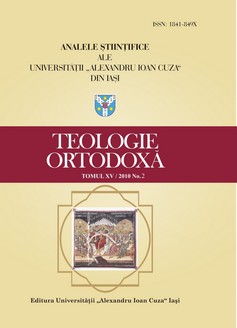Al. I. Cuza’s 1864 Decree and the Decree No. 410 of 1959 – comparative overview : context, content, consequences
Al. I. Cuza’s 1864 Decree and the Decree No. 410 of 1959 – comparative overview : context, content, consequences
Author(s): Ion VicovanSubject(s): Christian Theology and Religion
Published by: Editura Universităţii »Alexandru Ioan Cuza« din Iaşi
Keywords: monasticism; decree of Alexandru Ioan Cuza-1864; Decree 410/1959; the closing of monasteries and hermitages; reduction of monks and nuns
Summary/Abstract: Romanian monasticism is one of the oldest in Orthodoxy. Its value lies not only in its old age, but also in its complex work. Concretely, it gave birth to many saints, it brought a priceless contribution to the religious-moral formation of the Romanian people, it had an invaluable contribution to the cultural development of the nation, it carried a social-philantropical work in the midst of the people, it has been involved in the important achievements of the country’s history, it helped the Holy Places, etc. However, its history has not known only accomplishments, but has had aso great moments, of trial. Among these we will name only two of the most important: The Organic Decree for the Regulation of the Monastic Order, signed by the ruler Alexandru Ioan Cuza, on the 30th of November 1864, and The Decree No. 410 of the totalitarian communist regime, of the 28th of October 1959. Although they were established and enforced in diferent periods, at almost a century apart, and although they apparently had totally opposite influences, the first from the West, the second from the East, they both wanted to limit monasticism: to reduce the number of those who wanted to adopt a monastic life, as well as to close some of the monastic settlements. The enforcement of the two decrees lead, on the one hand, to the drastic decrease of the number of monks and nuns, to the closing and trasformation of some monasteries and hermitages into parish churches, but also to the reduction of the cultural and social-philantropical activities or the believers’ depriving of confessors over the course of many decades. However, despite the mentioned negative consequnces, we have the certainty that they were allowed by God, with an educational purpose, for the strengthening of monasticism, for us to realise its importance and to be fully aware of the “cross” it representes. Their history brings us, however, something to reflect upon: if in the XIX-th century the decree was influenced by the West, if in the XX-th century the decree was marked by the influences from the East, we must pray a lot so that in the XXI-st century, marked by secularization, God takes care of the monasticism; may He help all the monks and nuns fulfill with diligence the promises made to the One Who gave all the evangelical advise.
Journal: Analele Ştiinţifice ale Universităţii »Alexandru Ioan Cuza« din Iaşi. Teologie Ortodoxă
- Issue Year: 2010
- Issue No: 2
- Page Range: 141-157
- Page Count: 17
- Language: English

